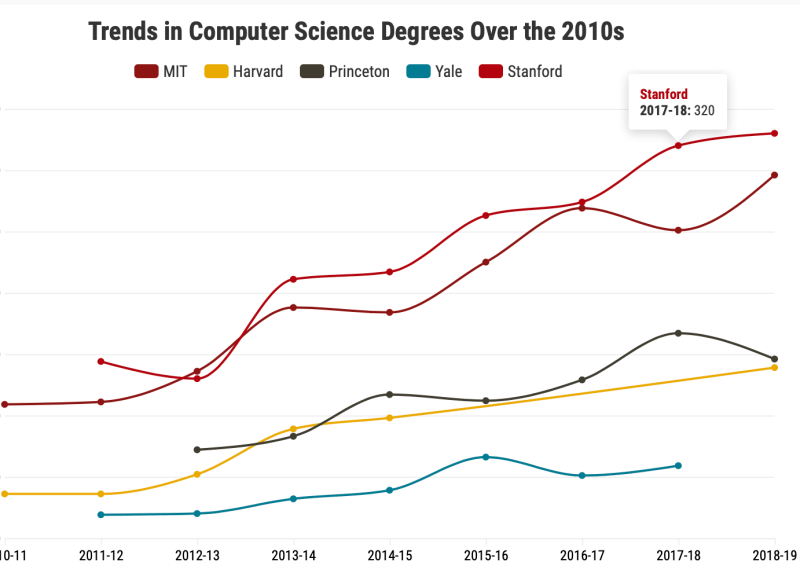Stanford in the 2010s is a series featuring data visualizations on how things changed (or did not change) in the University community. We will explore academics, athletics, social life and more. To leave suggestions, contact The Daily’s data team at data ‘at’ stanforddaily.com. Check out Part 1 of our series for a deep dive on majors at Stanford.
Recently, we looked at the trends in Stanford majors over the 2010s. In this article, we will see how trends in majors at Stanford compare to trends at Yale, Princeton, Harvard and MIT over the past decade. Although computer science (CS) showed some of the largest growth at each of these schools and was the most popular major at Stanford and MIT, economics proved to be the top choice of students at Harvard, Princeton and Yale.
The percent change over the decade is calculated using the average value over the first three and last three years of data as the baseline and endpoint values in order to smooth out fluctuations in the data that do not reflect a broader trend. Harvard does not provide information from 2015-16 to 2017-18, so the endpoint uses the final year of data. Furthermore, the majors shown are those that were claimed by at least 1% of the graduating class over the 2010s. Additional information about each major can be found by hovering over the bar chart.
Scroll through the charts below to see the trends in majors at Yale, Princeton, Harvard, MIT and Stanford.
Yale University
At Yale, technical subjects generally had the greatest percent increases, while humanities subjects tended to decrease over the decade. The distribution of social sciences is remained relatively even throughout. CS experienced the biggest boom in popularity, but it is far from the most popular major at Yale, as economics and political science top the list. In 2017-18, economics majors more than doubled CS majors in degrees conferred.
Updated at 9:58 a.m. PT on May 15: The biology major at Yale was split into “molecular, cellular and developmental biology” and “ecology and evolutionary biology” in 2012. “Biology” has thus been removed from the graph.
Princeton University
The B.S.E. in CS is much more popular than its B.A. counterpart, but both variations experienced the same percent growth in the 2010s. Again, technical fields enjoyed the greatest increases overall, while natural sciences saw many percent decreases. Non-STEM majors in the humanities and social sciences generally fell on the left side of the graph. Economics is the single most popular major at Princeton. However, if both CS programs are combined, CS is the most popular subject at Princeton, with economics as a close second.
Harvard University
In what is probably the most visually striking graph due to lopsidedness, CS takes the top spot for percent change. A majority of majors experienced percent decreases, but this was compensated by colossal spikes in interest for CS and statistics. Humanities subjects had the greatest drops, with subjects like Romance languages and literature along with East Asian studies at the far left. CS is Harvard’s second-most popular major, with economics as the overwhelming favorite.
MIT
The preferences of Stanford’s student body are perhaps mirrored mostly closely by those of MIT’s student body. This makes sense given Stanford’s proximity with Silicon Valley and MIT’s emphasis on technical subjects as evidenced by its name. But the numbers suggest that the STEM atmosphere at MIT is even more present than it is at Stanford. For degrees that were awarded to more than 1% of students, none of them were in the humanities, and all but two were STEM-related. Those two subjects, namely management science and economics, also experienced the greatest percent decrease. It’s also worth noting how heavily MIT has integrated CS into its degree offerings. For MIT’s class of 2019, more than 40% of students graduated with a degree that had “computer science” in the name.
The graph above summarizes the trends in CS across the five institutions we’ve looked at. The numbers for Princeton include both B.S.E. and B.A. degrees awarded in CS. The numbers for MIT are specifically for the computer science and engineering major. Harvard did not report numbers from 2015-16 to 2017-18. Unsurprisingly, Stanford and MIT show the highest rates of growth. CS degrees awarded at Yale sit below the other schools, while Princeton shows the most fluctuation from year to year.
Contact Sophie Andrews at sophie1 ‘at’ stanford.edu or The Stanford Daily Data Team at data ‘at’ stanforddaily.com.
